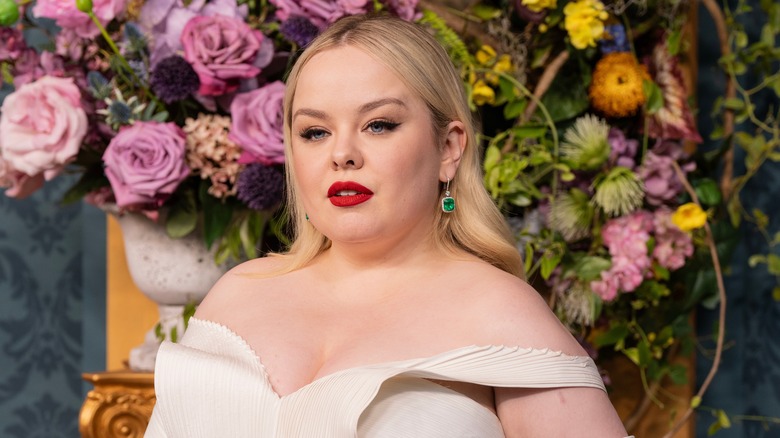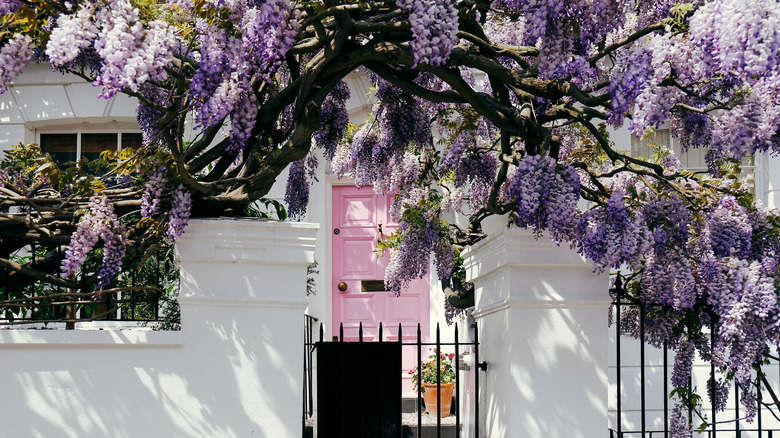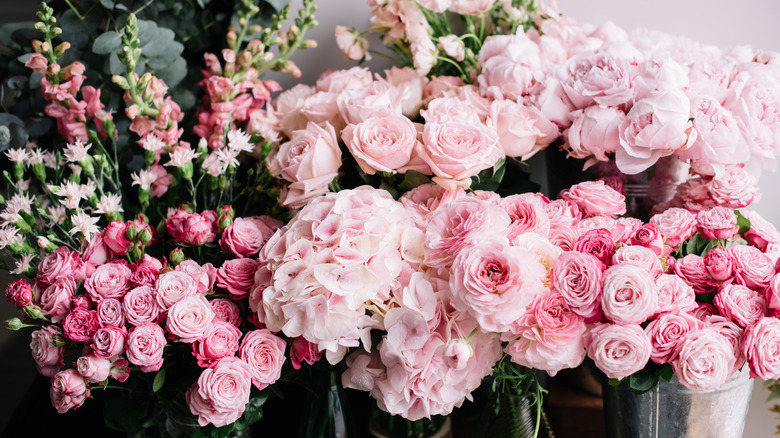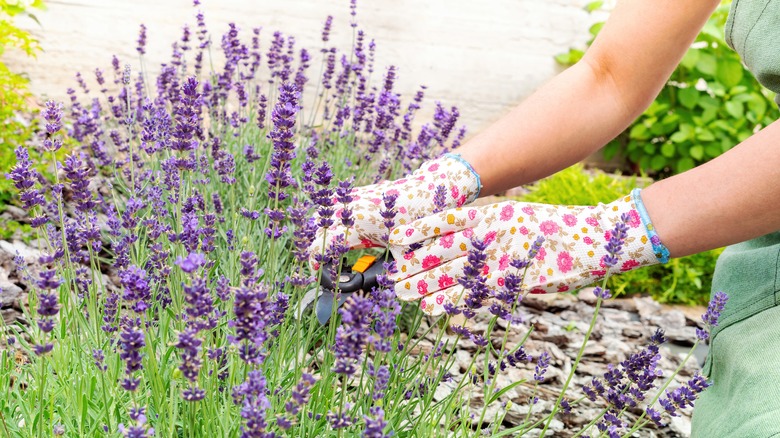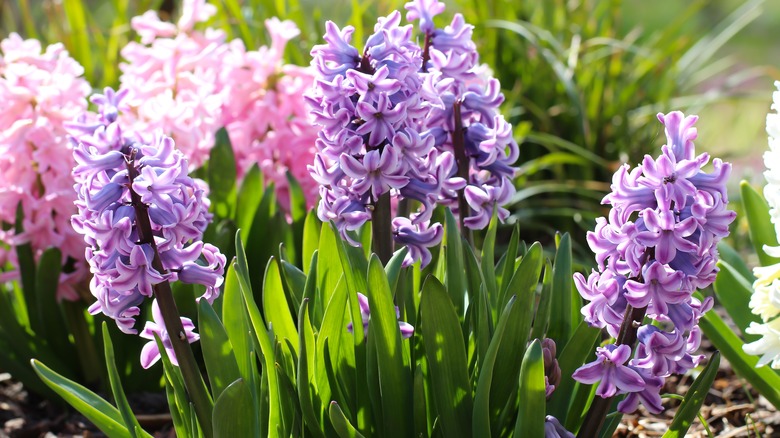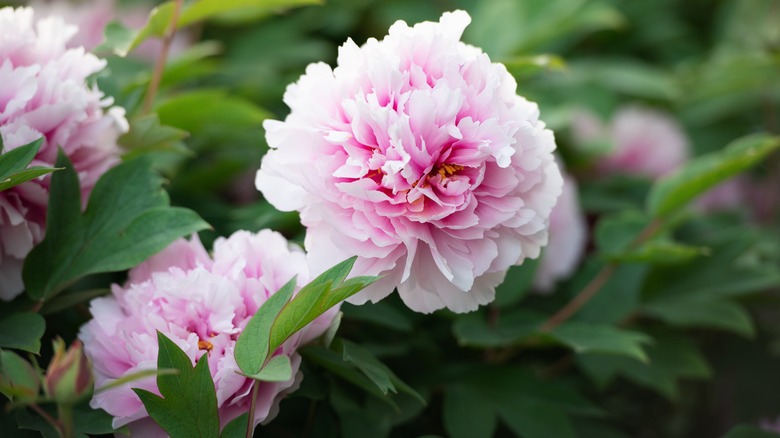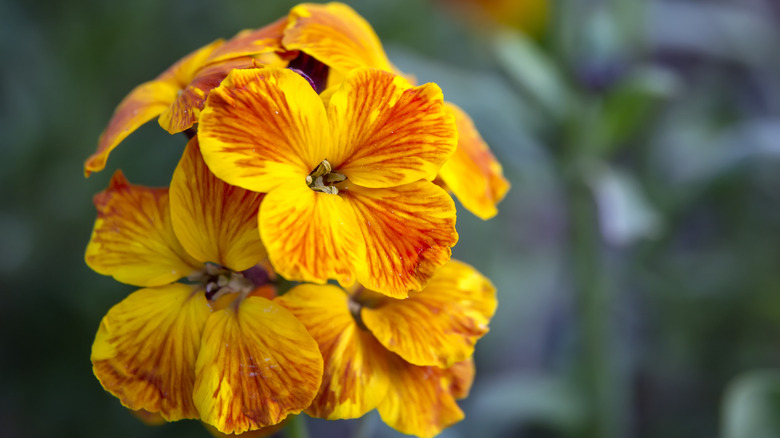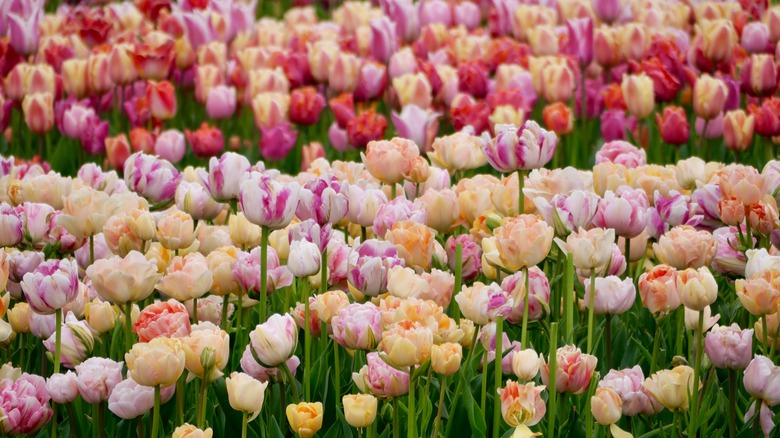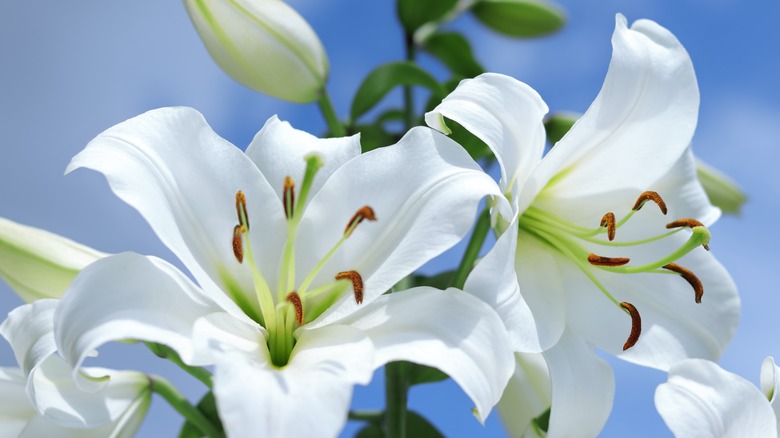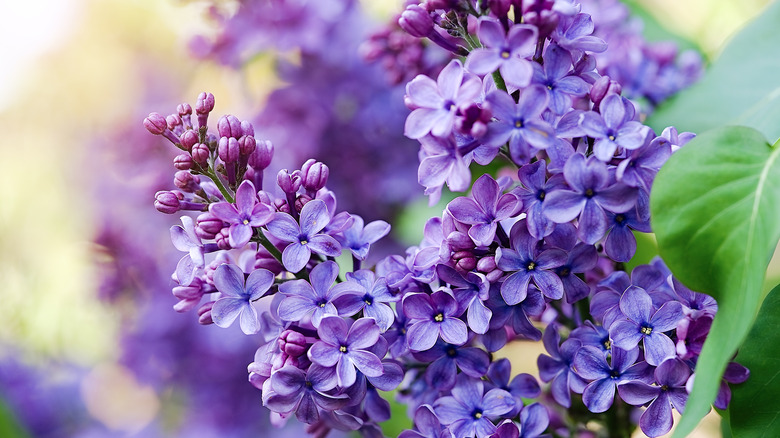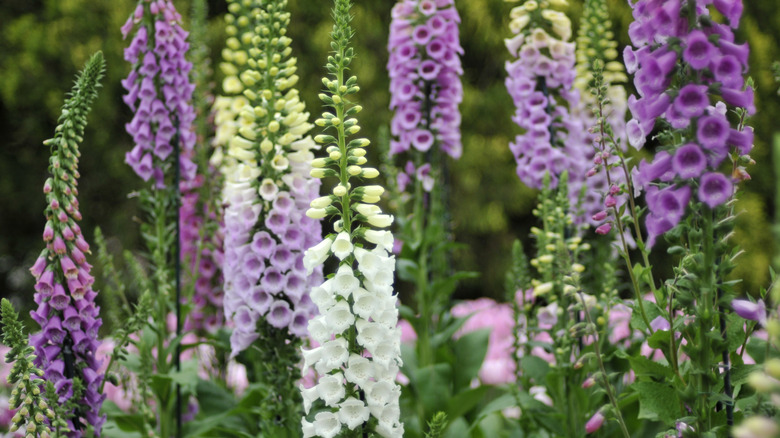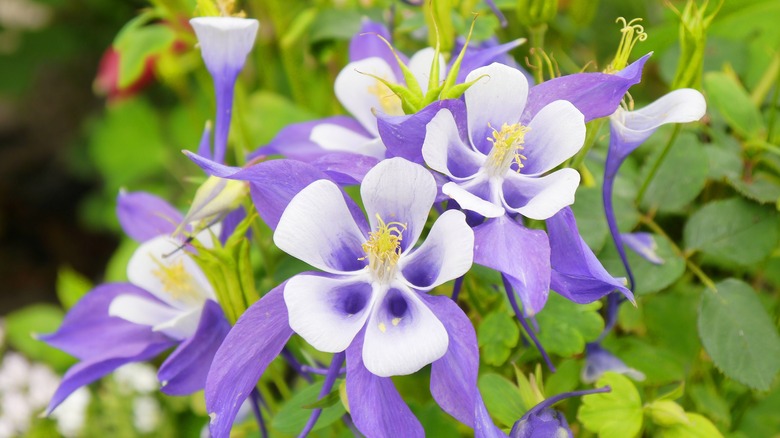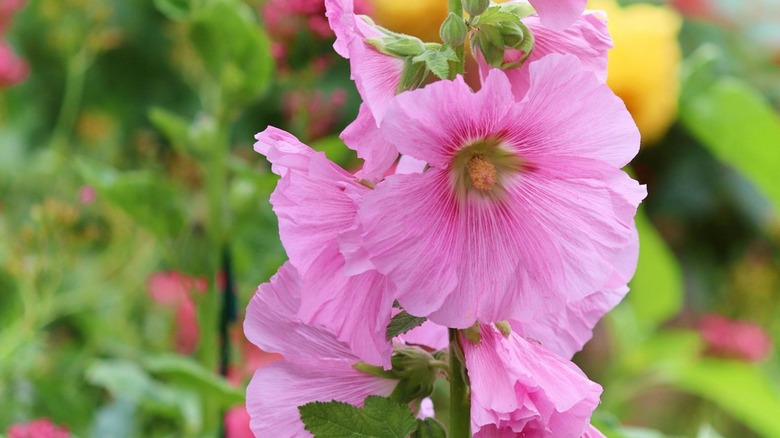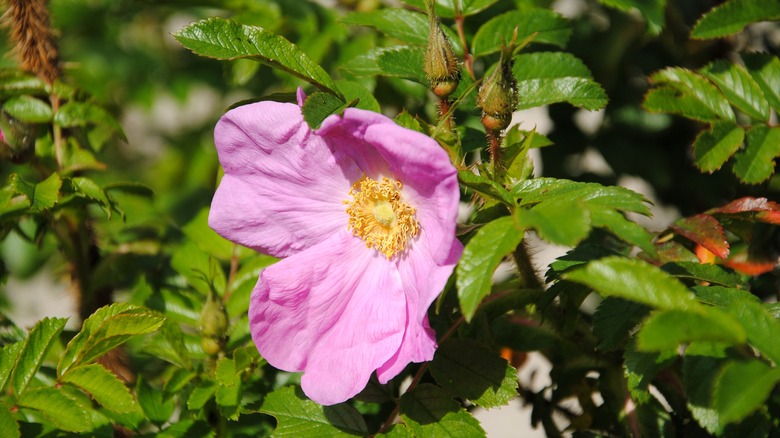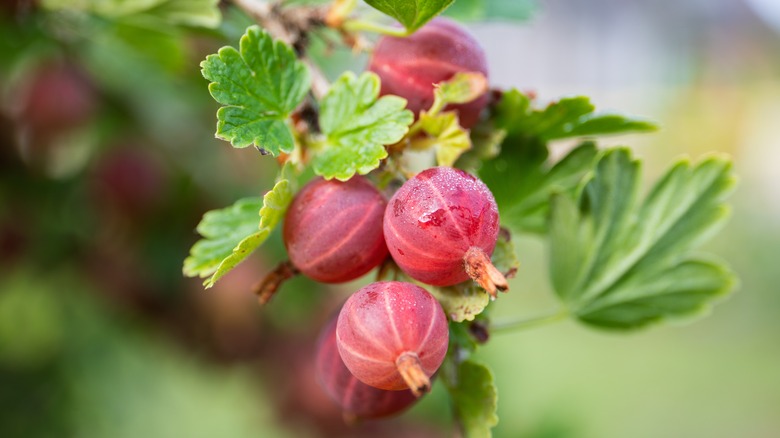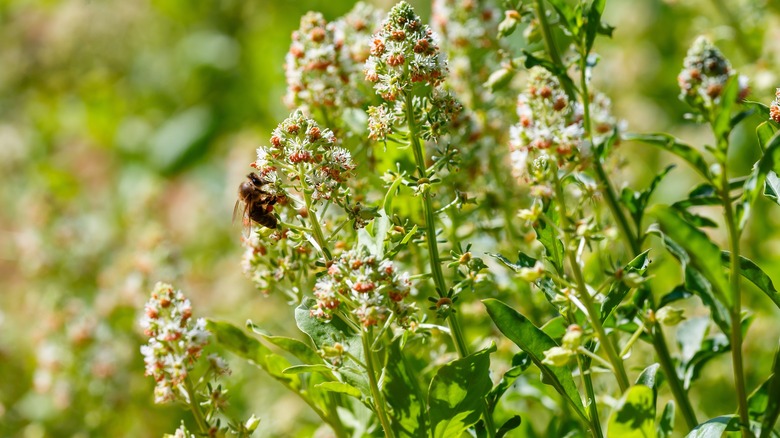Grow The Regencycore Garden Look Of Bridgerton With These 15 Flowers
The beautiful debutantes aren't the only ones in bloom on Netflix's "Bridgerton." Indeed, flowers, both in the garden and in the home, take center stage in this series. It makes sense to focus on flowers. Regency England was a time when the garden was an important feature of the home. Beautifully landscaped yards and parks were the sites for daily walks. Kitchen gardens, though less grand, provided fresh produce for families. If you'd like to let the Regency sensibility guide you in selecting your plants for this season's (or next season's) garden, take note.
There are many popular Regency plants that do well in most United States growing zones. However, because some plants are invasive, there may be cases where a simple swap will give you the look without the risk of overgrowth in your garden and surrounding wildlife. Scroll through our list to find plants that will delight the senses and bring a little of the grandeur of that bygone age to your own backyard.
1. Winding wisteria
Wisteria features prominently in the city and country gardens of "Bridgerton." Its purple flowers are stately when framing an arbor or reaching over a wall. Though beautiful, some varieties are invasive in the United States. Invasive types include Chinese and Japanese wisteria. For a stateside twist on this Regency-era classic, consider American wisteria. While this variety will spread, it's easier to control than non-native varieties. Though not as fragrant as its Asian counterparts, it's just as lovely. The plant is a natural climber, so help it reach its potential by planting it near a trellis, fence, arbor, or wall.
2. Roses in pastels
Pastel roses can lend glamor to your home, just as they do in the parlors and ballrooms of the ton. Create full bouquets of one type of rose or mix roses with other soft-colored flowers to create a visual harmony of complementary blooms. Before growing your own roses, know that they can be particular. Alternatively, you can opt for the lower maintenance Knock Out roses or easy-to-grow plants that look like roses. If you're up for the challenge, plant them within reach of a trellis since most varieties are climbers. Cut some to display inside your home.
3. Lovely lavender
Lavender is featured in Daphne's garden at her country estate. If you have well-draining, alkaline soil, lavender is a good drought-resistant choice for your estate. Test your soil's pH before you plant to see if it's suitable. If not, ameliorate the soil with additives to change the pH to a lavender-friendly range of 6.7 to 7.3. This sun-loving perennial is prone to root rot, so go easy with the sprinkler. With its color and scent, the blooms attract pollinators to the garden. However, the dried flowers make an affective moth repellent when placed in a sachet.
4. Heavenly hyacinth
Hyacinth is the name of the youngest Bridgerton, but it also grows in the gardens of their country estate. A popular flower in the Regency period, hyacinth is a harbinger of spring. Like all spring-blooming bulbs, hyacinth should be planted in the fall. A period of cold prompts it to grow when temperatures thaw. If you miss the planting season, you can force the bulbs. This process involves chilling bulbs in a cold, dark place, like the refrigerator, for 10 weeks. Remove them, and they'll bloom. To care for hyacinth, let the leaves die back completely before cutting them.
5. Pretty peonies
Peonies do best in full sun and favor a neutral pH. Plant peonies in the fall to allow them time to establish over winter. These perennials will return each year as long as you don't cut them back too soon in the fall. Allow the green leaves to stay until just after the first frost. This allows the plant to gather energy for the following spring. Peonies are needy flowers and don't share resources well with other plants. So, plant these flowers at some distance from others rather than crowding them in a full garden bed.
6. Wallflower
Much like the favorite wallflower of "Bridgerton," Penelope Featherington, this flower blooms in bright yellow and orange. It's also available in purple, pink, and blue. The sun-loving plant is hardy in zones 6 to 10. Depending on the variety, wallflowers are either perennial or annual plants. Deadhead spent blooms during the flowering season — early spring to midsummer. Then cut them nearly to the ground in the fall. Routine pruning keeps wallflowers from getting leggy and promotes spring growth. The wallflower belongs to the Brassicaceae (cabbage) family. Prevent pest infestations by keeping wallflowers out of beds where you've recently grown other plants in that family.
7. Trusty tulips
If you enjoy learning about the symbolic meanings of flowers, you may know that tulips symbolize passion. That's the common wisdom among folks who love the language of flowers; it's not just Violet Bridgerton who says so. Symbolism aside, these flowers are a hallmark of spring. As early bloomers, tulips bring colorful cheer. They come in countless colors and varieties. There are double tulips, too. As the name suggests, double tulips have more petals than regular tulips. There are also tulips that are terrific for beginner gardens. In any case, plant bulbs in the fall for spring blooms.
8. Lilies
Like the lily soap that Kate Sharma loves, lilies make a fragrant addition to the home. Although white lilies are a common flower for mourning, they need not be somber. Lilies come in different colors, too, such as pink. When added to a bouquet, they lend height and structure. Some cultivars have a less fragrant scent; nevertheless, they make a handsome bouquet. Cat lovers should be wary of these flowers. Lilies are highly toxic to feline friends and cause severe illness, or worse, if ingested. However, if your home is a cat-free one, lilies can be safely displayed.
9. Lilac, a symbol of love
According to Daphne Bridgerton, lilacs are symbolic of first love. This symbolism earns these flowers a place at the Bridgerton ball. However, their beautiful appearance and heady scent make them popular in today's gardens. Like most shrubs, lilacs are best planted in the spring or in the fall. They bloom in late April or early May. Typically purple, lilacs are also available in white or pink. Prune lilacs to keep them from becoming leggy. Do this in spring after blooms have faded. Don't prune too late, as this could prevent flowering the following year.
10. Dramatic foxglove
Foxglove brings forth tall stalks of colorful flowers. The summer-blooming plants are biennial, returning for two years. They can grow as tall as several feet. Each cultivar is different, so check the variety before planting to ensure it has adequate space to thrive. While garden centers sell mature foxglove plants for planting in summer, it's also common to buy them as small plugs. The smaller plants can be added to the garden in early spring or fall. This gives them time to mature before they make their debut in your garden.
11. Columbine
Columbine was a favorite of Jane Austen's — she even wrote about the flower in her letters. Columbine comes in multiple varieties, but the blue and white flower is one of the most common. A favorite with hummingbirds and other pollinators, it does best in sandy or loamy soils. If you live in a cooler zone, plant columbine in full sun. In hotter regions, choose a partly shaded area. Add mulch around the base of the plant to prevent evaporation. Columbine is perennial and will self-seed. Prune it to the base after blooming to encourage new growth and discourage pests.
12. Hollyhocks add height
Hollyhocks were a favorite in Regency-era gardens, and they're no less lovely today. The plant sends up tall spikes of flowers that can reach several feet high. Before planting, check the cultivar to determine how tall it might get. Not only does foxglove add drama to the garden but it's easy to grow from seed. Start seeds indoors several weeks before the last frost or sow them directly outdoors just before the last frost. Like most tall flowers, hollyhocks benefit from support. Place a trellis near these flowers to offer protection against strong winds.
13. Sweet briar for hedges
Sweet briar is an heirloom variety of rose. This historical flower was a favorite of William Shakespeare, Geoffrey Chaucer, and even the queen of Regency novels, Jane Austen. Available in white or pink, it has an apple-like scent. It can endure a range of temperatures in zones 4 to 9, allowing it to thrive in many parts of the United States. Sweet briar is often grown as a hedge due to its thorny branches (so beware when pruning). Sweet briar is grown for its hips, too, which can be harvested in fall. These fruits make a healthy, vitamin-rich tea.
14. Gooseberry in a food garden
Regency kitchen gardens were practical. Less grand than formal gardens, they sat close to the house and fed the family. Although gooseberry is grown for its fruit more than its flowers, the small blooms add some color to the warmer months in June through August. As a bonus, gooseberries can be used to make a Bridgerton-inspired dessert: gooseberry pie. Plant gooseberries in a sunny part of your yard, preferably in late fall. Gooseberry can fall prey to downy mildew. To prevent this, prune the plant annually to promote air flow.
15. Little migonnette
Another favorite of Jane Austen, mignonette has small white and orange flowers. It can grow as tall as 2 feet. It's an annual and can be grown from seed. It does best when grown in full sun or part shade. Sow seeds directly in the soil after the threat of frost has passed. For continuous blooms all summer, sow continuously for three weeks. Mignonette makes a long-lasting addition to floral arrangements. Cut stalks when just a third of the flower spike has bloomed. This ensures the other flowers open in the vase, lasting up to a week.
